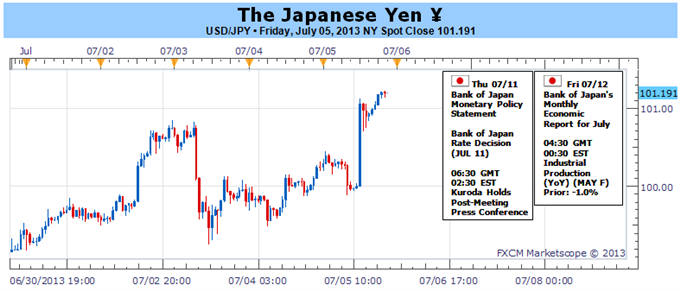
Why’s the Japanese Yen So Weak? One Reason it Could Fall Further
Fundamental Forecast for Japanese Yen: Bearish
Burst of the Bond Bubble could continue driving US Dollar higher
Looking for a potential short-term USDJPY turnaround as a buying opportunity
Were can we find higher interest rates? A look across the globe.
The Japanese Yen tumbled against the US Dollar as a sharply better-than-expected US Nonfarm Payrolls report pushed the Greenback’s yield advantage versus the JPY to its largest in 2 years. The highly interest rate-sensitive Yen could fall further as global yields continue their recent surge.
Attention now turns to the coming week’s Bank of Japan Monetary Policy meeting, and it will be particularly interesting to watch how BoJ Governor Kuroda reacts to recent financial market turmoil.
BoJ officials are unlikely to announce any new easing measures; Japanese economic data generally suggests that domestic growth remains firm. But the central bank has the nasty habit of defying market expectations, and anything is possible at its upcoming meeting. Any hints of further QE or obvious concerns over recent financial market volatility could send the Yen even lower.
But why is the Yen falling so sharply? It remains the worst-performing G10 currency on a year-to-date basis, and only the South African Rand has fallen more among major global currencies. Most of JPY weakness can be attributed to the Bank of Japan’s aggressive Quantitative Easing. But the BoJ announced its QE in April, and we would argue that much of that trade has played out so far.
Instead we look to a much larger market theme: a burst of the “Bond Bubble” is sending global yields substantially higher, while relatively steady Japanese rates encourage domestic investors to move capital abroad. We believe that rising yields may continue to hurt the Japanese Yen against major counterparts.
Our Senior Technical Strategist cautions that the USDJPY may see a significant near-term reversal off of current levels, but the longer-term trend seems fairly clear. The US Dollar is the world’s best-performing currency year-to-date, while the Japanese Yen is second-worst.
We’ll watch for sharp short-term pullbacks. The overall market trend suggests that major USDJPY declines could be treated as good long-term buying opportunities. –DR
DailyFX provides forex news and technical analysis on the trends that influence the global currency markets.Learn forex trading with a free practice account and trading charts from FXCM.
Source: Daily fx